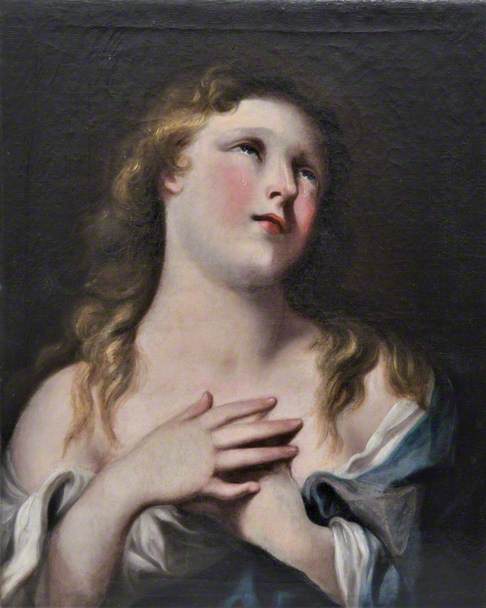Continental European before 1800, South East England: Artists and Subjects 10 comments What more can be established about this painting of Mary Magdalene?

Photo credit: Brighton & Hove Museums
[Discussion initiated on behalf of Stig Evans, Paintings Conservator, Royal Pavilion & Museums Trust, Brighton] I am the paintings conservator here at the Royal Pavilion and Museums Trust and I am trying to find out more about this painting in our Collection. We do not have much information on this painting and as its going through a program of cleaning I have been trying to investigate further and I wanted to contacted the Art Detectives on the Art UK site. The Magdalene frame is a modern pine slip frame and the stretcher has one inscription on it (attached) – and the painting has been lined, I am afraid that’s all we have to go on. [Group leader: Xanthe Brooke]
10 comments
Marion Richards has added: ‘This went through Art Detective in 2019, when the title was updated from 'Head of a Saint' to 'Mary Magdalene', based on comments from Jacinto Regalado and the NICE Paintings record.’
This is in the vein of Guido Reni but obviously by a minor hand, possibly as late as 19th century. It looks like a copy or a picture derived from 17th C Italian work.
Could this be by the French artist Antoine Coypel (1661–1722)? I have attached a composite based on this work and an image on Wikimedia of his ‘Susannah accused of adultery’, “between 1695 and 1696”. https://tinyurl.com/yc3vuv8x
Sir Anthony van Dyck was quarantined in Palermo in Sicily by plague. At that time he painted a series of pictures of Santa Rosalia. At least one is still in Palermo. Others are in the Apsley House collection, the Metropolitan Museum and the Prado.
This appears to me to be modelled on the heads of those pictures. It is probably English or Flemish.
It would be of interest to discover whether is is a small work by the master himself.
However there is something a bit soppy and Victorian about this particular image.
https://commons.wikimedia.org/wiki/File:Anthony_van_Dyck_-_Saint_Rosalie.jpg
https://commons.wikimedia.org/wiki/File:Anthony_van_Dyck_-_Saint_Rosalie_Interceding_for_the_Plague-stricken_of_Palermo.jpg
https://commons.wikimedia.org/wiki/File:Antoon_van_Dyck_-_Santa_Rosalía_intercediendo_por_la_ciudad_de_Palermo.jpg
https://commons.wikimedia.org/wiki/File:Saint_Rosalia_-_Anthony_Van_Dyck_-_Palazzo_Abatellis_-_Palermo_-_Italy_2015.JPG
https://commons.wikimedia.org/wiki/File:Anthony_van_Dyck,_St_Rosalie_in_Glory,_1624,_Oil_on_canvas,_Menil_Collection.jpg
I would consider this painter and painting - see attachments below
Girolamo Troppa (1637–1710)
Italian artist, born in Rome
Painted between 1651 and 1670
Medium oil on canvas
Collection
Statens Museum for Kunst
Location Copenhagen, Denmark
The model looks like the same woman, the expression is alike, as are the hands. Most importantly, the model has a particular nose shape, very narrow and pointed, with a sharp tip. The painting style is similar also, less 'bravura' that a more established artist, especially Van Dyck.
Troppa, let alone van Dyck, was better than this. The painting of the hands alone is sufficient to see that.
Maybe a copy of a lost 17th century original, by Troppa, Coypel or A.N.Other?? Copying paintings by established artists was widespread in the 19th century and earlier; it was considered an important part of an artist's training; the N.G. even set aside special days for this purpose. (Also - I hate to mention this in relation to this particular work - 'Anonymous' was often a woman).
I agree with Tamsyn - someone has copied a work by van Dyck. I still think it was Antoine Coypel. Here is an engraving by Gaspard Duchange after Coypel at the Met. I have attached a composite.
'The penitent Mary Magdalene in the wilderness'
1682–1757
https://tinyurl.com/mr4btj3f
Marcie, our picture employs a stock Magdalen pose which is not specific to any painter. It is either a copy or a derivative version by a lesser hand. I see no compelling reason for Coypel as the source.
I’m sure you’re correct, Jacinto. A work by Coypel with the title ‘Penitent Magdalen’ was in an auction in Manchester March 27-28, 1839 (collection of Thomas Appleby, Esq.) but I can’t link it to this work.
